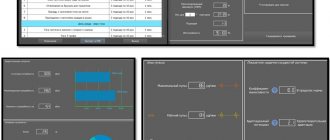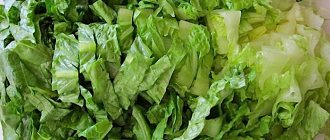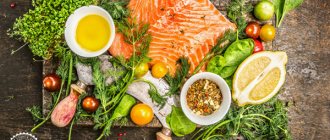Calorie intake per day
As such, there is no single and generally accepted daily calorie intake. According to the recommendations of the World Health Organization, “energy entering the body (in calories) must be balanced with energy expended.” Thus, your individual calorie intake depends, first of all, on the nature of your work, level of physical activity, gender, age and a number of other factors. However, on the Internet you can find many tables and calculators of unknown origin, offering information on daily values, supposedly based on authoritative sources. We believe that the quality of this information is quite questionable.
The most reliable way to determine individual calorie needs is to simply calculate the energy value of food consumed during the day (or several days). Just record your normal daily diet on paper. Write down what and how much you ate during the day. Calorie content can be directly calculated using information from product labels and using our website. Provided that you are healthy and your weight does not change much with your current diet, the results obtained can be conditionally considered your daily norm.
To lose weight, you need to slightly reduce your daily energy intake. If you maintain your current lifestyle, you will experience a slight calorie deficit because your costs will remain the same. This will lead to the gradual burning of your fat reserves. What exactly the deficit should be is up to you to decide. We strongly advise against increasing it sharply, because... it won't lead to anything good. Reduce your calorie intake gradually and lose weight slowly. This way you won’t have to torture yourself and break down from time to time. And of course, before making any dietary changes, we strongly recommend that you consult with your doctor or qualified dietitian.
Calorie calculation formula
I go into the store and see rows of semi-finished products: cutlets, pancakes, mixed vegetables... All packages have calorie content indicated. And I need to count my dish, which is not in the store, and it consists of more than one product. To do this, I use step-by-step instructions for calculating calories.
My calculations are very simple, in “manual mode”. I do all food weighing in the same units of measurement - grams. I also count liquids in grams.
I write down information about the calorie content per 100 g of each product included in the dish from the packaging or label. You can take it from calorie tables - from a book, website, mobile application. Whichever is more convenient. But more precisely - from a specific package.
I determine the raw weight of all the ingredients in the dish. I weigh each ingredient on a kitchen scale and write down the weight in grams.
I count the calorie content of each ingredient: I take into account the weight of the product in the dish. One way: divide the calorie content in 100 g by 100 and multiply by the weight of the ingredient in grams.
I calculate the total calorie content of the dish. I add up the calorie content of all ingredients in the table.
I determine the final weight of the dish on the scales. If I sum up the weight of all ingredients in their raw form, then boiling or evaporation will not be taken into account. Therefore, I weigh the finished dish.
I substitute the numbers from step 4 and 5 into the formula.
K100 = Ks x 100 / Vg
K100 - calorie content per 100 grams of the finished dish Kc - total calorie content of the dish (step 4) Wg - weight of the entire finished dish (step 5)
But that is not all. I don't eat 100 gram portions. More often than not.
I count the calories in a serving. The most important thing in all calculations is what I will put on my plate and eat.
Kp = K100 / 100 x Vp
Kp - calorie content of my serving K100 - calorie content per 100 grams of the finished dish Wp - serving weight
Now I know how many calories are on my plate. Eat everything or put less, healthy calories or not - this is food for thought and a topic for another article. Now I’ll do the calculation using examples. This is how information is absorbed better, for me for sure))
How to create a deficit
Creating a deficit can be achieved in three ways: diet, increased physical activity, or a combination of the first and second. The last option is more correct and easier, because if you choose a strict diet, you will have to limit yourself in many ways and suffer from hunger. Physical activity alone will result in too slow weight loss, without creating the necessary lack of glucose at which weight loss begins. The combination of sports with proper nutrition and diet will take calories evenly, which will allow you to maintain a normal diet while losing weight.
Fats burn in the fire of carbohydrates
It is carbohydrates that help burn fat. Therefore, to lose weight, choosing higher carbohydrates and a lower percentage of fat can achieve the desired weight without compromising your health.
Attention: Before using any methods that may affect your health, consult your doctor. Any calculation is not intended for you if you already have health problems.
standard ratio of proteins, fats, carbohydrates
To calculate BJU for weight loss, it is recommended to consume BJU on the day in the following ratio:
- 50% carbohydrates (4 calories per gram)
- 30% protein (4 calories per gram)
- 20% fat (9 calories per gram)
Protein is required to develop muscles and increase our metabolism, but we can only absorb 25-40 grams per meal. And your age is also important. Too much protein in our system is processed by our kidneys and liver. Even though protein contains no fat, excess will be converted to fat.
Carbohydrates are essential for all of our body systems to function properly. The brain and central nervous system are almost entirely dependent on glucose.
Nutrient-dense carbohydrates increase micronutrient intake, control blood sugar levels, and are a major source of energy.
Keeping carbs to a minimum will make you tired and hungry.
Excess fast carbohydrates (highly processed carbohydrates) increase insulin levels in the blood and ultimately lead to the accumulation of fat in the body.
So no need to cut out good carbs, enrich your diet with plenty of fresh fruits and vegetables for endless energy throughout the day!
There are many reasons why fats should be present in our diet.
- To balance our hormones.
- Formation of our brain and nervous system.
- Healthy skin and hair.
- For the absorption of fat-soluble vitamins.
- Fats are the most concentrated source of energy at 9 calories per gram.
So while 20% of our daily caloric intake should come from fat. They will provide the greatest nutritional value to our body. Cut back on saturated fats and add unsaturated and polyunsaturated fats.
Too much saturated fat in the diet is linked to high cholesterol, heart disease, Alzheimer's disease, breast cancer, kidney disease, diabetes, multiple sclerosis, stroke and prostate cancer.
So the next time you decide to eat something deep-fried or a pork burger, take a close look at it. What you will see is memory loss, cancer, disease and stroke. There are many recipes that are more nutritious and have less saturated fat.
Many of us don't drink enough water and don't even realize it. It is the slightest dehydration that can hinder our body's metabolism and also reduce our energy levels, since water is necessary for energy production and serves as a conductor of oxygen. If you feel like you can't drink 2 liters of water, then just start doing it.
Today it is very easy to keep track of what you eat and how much you eat.
In order to calculate the KBZHU for weight loss, you can use websites or an application on your phone. One of these free applications: FatSecret or you can look at a review of other BZHU calorie tracking applications.
Why do you need a calorie counter?
A calorie counter will help you plan a diet that will help you achieve your goal of losing or gaining weight. You can easily and quickly count calories online, changing your menu on the go.
But before you use the calorie counter, determine your daily calorie intake. You will find out how many kcal per day you need to lose weight, lose weight quickly, gain weight or not change your weight.
Knowing this figure, using a calorie counter, you can create your menu for the day in such a way that the calorie content of all dishes does not exceed the daily allowance. Calories are calculated online, you can immediately adjust and select the best diet option.
How to eat healthy
When determining for yourself how many calories you need to consume to lose weight, it is important to maintain a balance and ensure that the body receives all the necessary vitamins and microelements (proteins, carbohydrates). Otherwise, it will negatively affect the condition of the skin, nails, hair, etc. Even products such as oils and fats cannot be completely excluded; you just need to use them correctly and in the right quantities. For example:
- get rid of frying in oil;
- eat more low-calorie vegetables and fruits;
- include nutritious cereals and legumes in the diet due to their satiety;
- combine compatible foods in one meal;
- get glucose from healthy sweets (dried fruits, nuts and honey);
- divide meals into 4-5 times, reducing portion sizes.
- How to calculate kbju for women for weight loss
- Breathing exercises for losing belly fat: exercises, video. Breathing to lose belly fat: how to do it correctly
- The Most Natural Supplement for Weight Loss: How to Take Flax Seeds. How to use flax seeds for weight loss
- Jennifer Aniston's diet for slimness
Harris–Benedict formula
The authors developed the original version in 1919. To compile it, scientists studied 239 people of different genders and ages with different weights. Seventy years later, the formula was revised and refined. Now it is calculated using the following formulas.
For men
. 88.36 + (13.4 x own weight) + (4.8 x own height) - (5.7 x age). As a result, you will get the result of the required calorie intake.
For women
. 447.6 + (9.2 x weight in kilograms) + (3.1 x height in centimeters) - (4.3 x age).
In this case, the resulting results must be multiplied by the daily activity coefficient, which is determined depending on the amount of physical exercise within a week. If such calculations seem too complicated, you can use an online calculator: it will calculate everything for you.
Calculation of calorie content of a side dish
For example, I will count baked eggplants with tomatoes and cheese. This side dish can be a separate dish.
Raw eggplants before baking
| Ingredients | Calorie content per 100 g, kcal | Product weight in dish, grams | Calorie content, kcal |
| Eggplant | 24 | 700 | 168 |
| Tomatoes | 20 | 200 | 40 |
| Garlic | 150 | 10 | 15 |
| Cheese "Russian" | 363 | 100 | 363 |
| Vegetable oil | 900 | 5 | 45 |
| Salt | 0 | 5 | 0 |
| TOTAL | 1020 | 631 |
Weight of finished dish (weighing to account for weight reduction during baking) = 904 grams
K100 = Ks x 100 / V g = 631 x 100 / 904 = 70 kcal
In this calculation, the calorie content is also a little high, since I did not subtract from the calculation the vegetable oil that I had left on the baking sheet.
My serving of eggplant is 114 kcal
For a recipe for baked eggplant, see my article on 10 low-calorie side dishes.
Calorie calculation for an omelet made from 2 eggs with milk
I will give an example of calculating a simple recipe for an omelette in a frying pan, which includes only 4 ingredients.
| Ingredients | step 1 Calorie content per 100 g, kcal | step 2 Weight of product in dish, grams | step 3 Calorie content, kcal |
| Egg category 1, 2 pcs. | 157 | 120 | 188 |
| Milk 2.5% fat | 52 | 60 | 31 |
| Vegetable oil | 899 | 5 | 45 |
| Salt | 0 | 3 | 0 |
| TOTAL for an omelet of 2 eggs | 189 | 264 - step 4 |
I count the calories in an omelet made from 2 eggs.
The omelet is prepared according to a simple recipe: break 2 eggs into a bowl, add salt, beat well with a whisk, then add milk. I stir and pour the mixture into a heated frying pan with vegetable oil. All that remains is to count the calories.
The weight of the dish changed: I weighed the eggs in their shells. Weight of the finished dish: 175 grams.
K100 = Ks x 100 / Br = 264 x 100 / 175 = 151 kcal
I eat an entire omelet for breakfast, and the calorie content of a serving of 2 eggs with milk is 264 kcal.
I took the calorie numbers from the packaging of foods that I have in my kitchen. Data may vary, for example eggs of a different category or milk. If you do not change the cooking recipe, the order of the numbers remains the same.
The calorie content will increase if I change the ingredients: I sprinkle cheese on top of the omelette or add flour. And if I decide to cook my favorite fluffy omelette with vegetables, then the kcal number will decrease by 100 grams.










